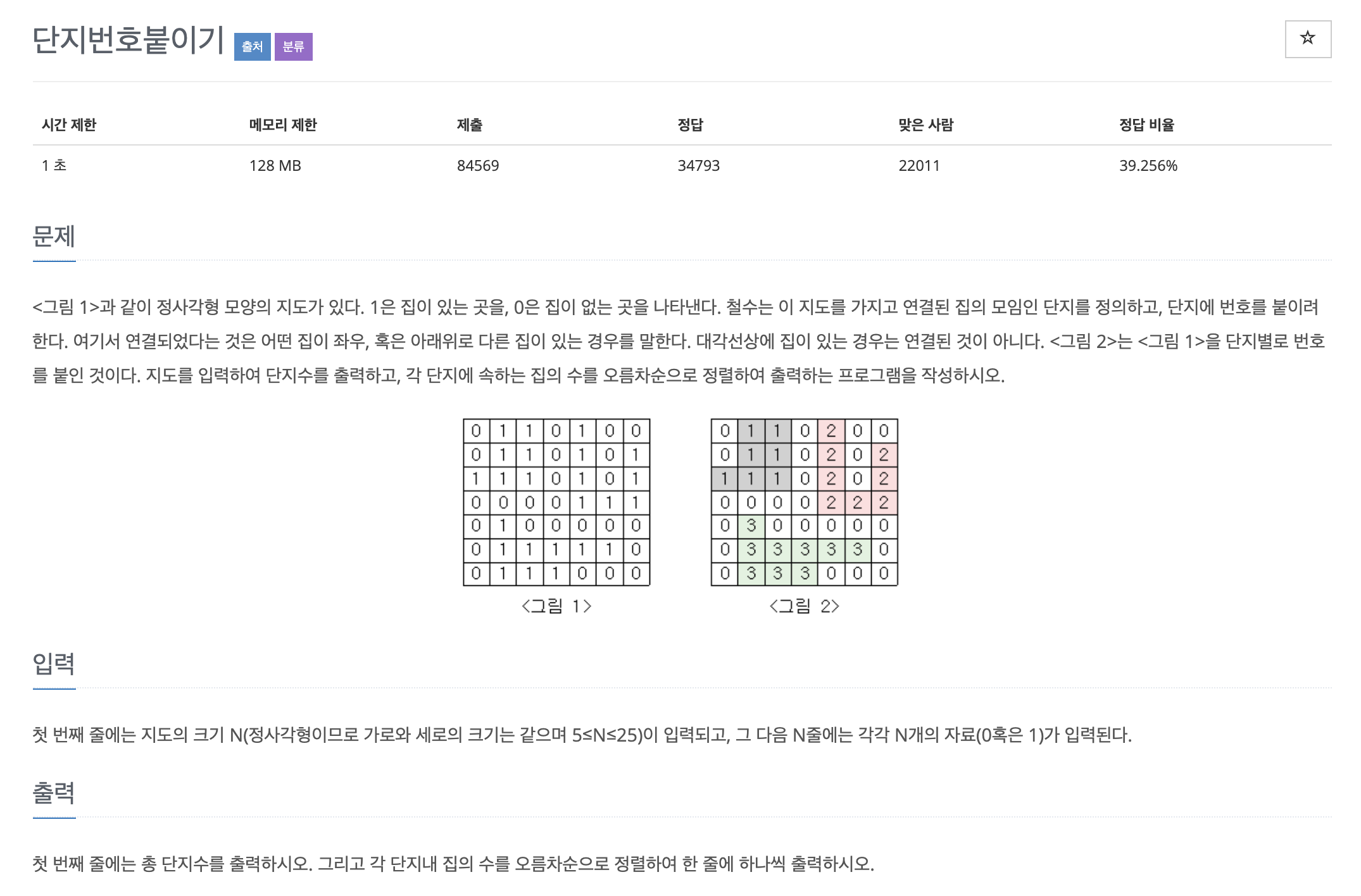Baekjoon Online Judge
algorithm practice
- 단계별 문제풀기
24. DFS와 BFS
그래프를 순회하는 알고리즘을 배워 봅시다.
Java / Python
3. 단지번호붙이기
2차원 배열을 그래프로 표현해 BFS나 DFS로 순회하는 문제

이번 문제는 지도를 입력하여 단지수를 출력하고, 각 단지에 속하는 집의 수를 오름차순으로 정렬하여 출력하는 프로그램을 작성하는 문제입니다.
- 입력
첫 번째 줄에는 지도의 크기 N(정사각형이므로 가로와 세로의 크기는 같으며 5≤N≤25)이 입력되고, 그 다음 N줄에는 각각 N개의 자료(0혹은 1)가 입력된다.- 출력
첫 번째 줄에는 총 단지수를 출력하시오. 그리고 각 단지내 집의 수를 오름차순으로 정렬하여 한 줄에 하나씩 출력하시오.
DFS(Depth-First Search) : 깊이 우선 탐색
- 재귀나 스택으로 구현
- 특정 노드에서 시작해 다음 분기로 넘어가기 전에 해당 분기를 완벽하게 탐색하는 방법
BFS(Breath-First Search) : 너비 우선 탐색
- 큐로 구현 (FIFO원칙으로 탐색)
- 시작 정점으로부터 가까운 정점을 먼저 방문하고 멀리 떨어져 있는 정점을 나중에 방문하는 순회 방법
- Java
import java.io.*;
import java.util.*;
public class Main {
static int[] dx = {-1, 1, 0, 0}; // 상하좌우
static int[] dy = {0, 0, -1, 1}; // 상하좌우
static int N, cnt; // 지도의 크기, 집 숫자
static int[][] Map; // 지도
static boolean[][] check; // 방문 여부
static ArrayList<Integer> result = new ArrayList();
public static void main(String[] args) throws IOException {
BufferedReader br = new BufferedReader(new InputStreamReader(System.in));
BufferedWriter bw = new BufferedWriter(new OutputStreamWriter(System.out));
N = Integer.parseInt(br.readLine());
Map = new int[N][N];
check = new boolean[N][N];
// 지도 입력 받기
for(int i = 0; i < N; i++){
String str = br.readLine();
for(int j = 0; j < N; j++){
Map[i][j] = str.charAt(j) - '0';
}
}
for(int i = 0; i < N; i++){
for(int j = 0; j < N; j++){
if(Map[i][j] == 1 && !check[i][j]){
cnt = 1;
bfs(i,j);
result.add(cnt);
}
}
}
Collections.sort(result);
bw.write(result.size() + "\n");
for(int i = 0; i < result.size(); i++)
bw.write(result.get(i) + "\n");
bw.flush();
bw.close();
br.close();
}
public static int bfs(int x, int y) {
check[x][y] = true;
for (int i = 0; i < 4; i++) {
int nx = x + dx[i];
int ny = y + dy[i];
if (nx >= 0 && ny >= 0 && nx < N && ny < N){
if(Map[nx][ny] == 1 && !check[nx][ny]){
bfs(nx, ny);
cnt++;
}
}
}
return cnt;
}
}- Python
import sys
N = int(sys.stdin.readline())
graph = [list(sys.stdin.readline()) for _ in range(N)]
cnt = 0
apt = []
def dfs(x, y):
dx = [1, -1, 0, 0]
dy = [0, 0, 1, -1]
global cnt
graph[x][y] = '0'
cnt += 1
for i in range(4):
nx = x + dx[i]
ny = y + dy[i]
if N > nx >= 0 and N> ny >= 0 and graph[nx][ny] == '1':
dfs(nx,ny)
for i in range(N):
for j in range(N):
if graph[i][j] == '1':
cnt = 0
dfs(i, j)
apt.append(cnt)
print(len(apt))
apt.sort()
for i in apt:
print(i)